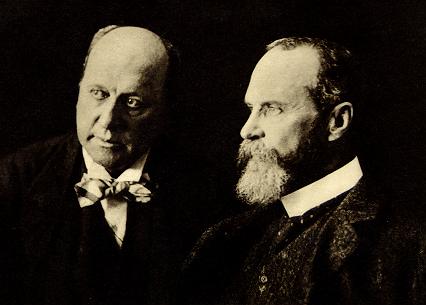"Bernanke an Expert on the Great Depression??"
One of the reasons I am partial to Australians is that they are critical thinkers, not easily cowed by authority or conventional wisdom.
In the US, one of the reasons that Fed chair Ben Bernanke is given so much deference (aside from the fact that we treat people in positions of power with kid gloves) is that he is regarded as an expert on the Great Depression, and has also studied Japan's Lost Decade.
Steve Keen, author of Debunking Economics and professor at the University of Western Sydney, has taken a look at some of Bernanke's writings on the Great Depression and finds them wanting, Serious wanting. I've read some of Bernanke's work on Jaoan, and quite a few of his speeches, and was bothered by some of the assumptions and omissions. Keen tears into Bernanke with a gusto that I find refreshing.
This is a long excerpt from a much longer and worthwhile post (hat tip reader Tom):
A link to this blog....reminded me of Bernanke’s book Essays on the Great Depression, which I’ve been aware of for some time but have yet to read. I’ll make amends on that front early this year; fortunately, an extract from Chapter One is available as a preview on the Princeton site (I couldn’t locate the promised eBook anywhere!; in what follows, when I quote Bernanke it is from the original journal paper published in 1995, rather than this chapter).I like Minsky's work, but I find it much less useful than Fisher's work. Anyway, this post is incorrect in a number of ways:
To put it mildly, Bernanke’s analysis is not promising.
The most glaring problem on first glance is that, despite Bernanke’s claim in Chapter One “THE MACROECONOMICS OF THE GREAT DEPRESSION: A Comparative Approach” that he will survey “our current understanding of the Great Depression”, there is only a brief, twisted reference to Irving Fisher’s Debt Deflation Theory of Great Depressions, and no discussion at all of Hyman Minsky’s contemporary Financial Instability Hypothesis.
While he does discuss Fisher’s theory, he provides only a parody of it–in which he nonetheless notes that Fisher’s policy advice was influential:Fisher envisioned a dynamic process in which falling asset and commodity prices created pressure on nominal debtors, forcing them into distress sales of assets, which in turn led to further price declines and financial difficulties( A CALLING RUN ). His diagnosis led him to urge President Roosevelt to subordinate exchange-rate considerations to the need for reflation, advice that (ultimately) FDR followed.( I HAVE NOW LINKED TO FISHER'S PAPER AT THE ST.LOUIS FED. THE ONLY REASON I HAVEN'T SCANNED IT ON THIS BLOG IS THAT I CAN'T SEEM TO COPY IT OFF THE PDF. TO BE PLAIN, MY CALLING RUN AND PROACTIVITY RUN IDEAS ARE MY VERSION OF FISHER, JUST AS MY VIEW OF BANKING IS BASED ON BAGEHOT AND INVESTING BASED ON GRAHAM. OBVIOUSLY I HAVE ADAPTED THEIR VIEWS IN ORDER TO MAKE THEM SOUND LESS CONVINCING. )
He then readily dismisses Fisher’s theory, for reasons that are very instructive:Fisher’s idea was less influential in academic circles, though, because of the counterargument that debt-deflation represented no more than a redistribution from one group (debtors) to another (creditors). Absent implausibly large differences in marginal spending propensities among the groups, it was suggested, pure redistributions should have no significant macroeconomic effects. ” (Bernanke 1995, p. 17)
This is a perfect example of the old (and very apt!) joke that an economist is someone who, having heard that something works in practice, then ripostes “Ah! But does it work in theory?”.
It is also–I’m sorry, there’s just no other word for it–mind-numbingly stupid. A debt-deflation transfers income from debtors to creditors? From, um, people who default on their mortgages to the people who own the mortgage-backed securities, or the banks?
Well then, put your hands up, all those creditors who now feel substantially better off courtesy of our contemporary debt-deflation…
What??? No-one? But surely you can see that in theory…
The only way that I can make sense of this nonsense is that neoclassical economists assume that an increase in debt means a transfer of income from debtors to creditors (equal to the servicing cost of the debt), and that this has no effect on the economy apart from redistributing income from debtors to creditors. So rising debt is not a problem.
Similarly, a debt-deflation then means that current nominal incomes fall, relative to accumulated debt that remains constant. This increases the real value of interest payments on the debt, so that a debt-deflation also causes a transfer from debtors to creditors–though this time in real (inflation-adjusted) terms.
Do I have to spell out the problem here? Only to neoclassical economists, I expect: during a debt-deflation, debtors don’t pay the interest on the debt–they go bankrupt. So debtors lose their assets to the creditors, and the creditors get less–losing both their interest payments and large slabs of their principal, and getting no or drastically devalued assets in return. Nobody feels better off during a debt-deflation (apart from those who have accumulated lots of cash beforehand). Both debtors and creditors feel and are poorer, and the problem of non-payment of interest and non-repayment of principal often makes creditors comparatively worse off than debtors (just ask any of Bernie Madoff’s ex-clients).
Having dismissed–and barely even comprehended–the best contemporary explanation of the Great Depression, Bernanke is now trapped repeating history. It is painfully obvious that the real cause of this current financial crisis was the excessive build-up of debt during preceding speculative manias dating back to the mid-1980s. The real danger now is that, on top of this debt mountain, we are starting to experience the slippery slope of falling prices.
In other words, the cause of our current financial crisis is debt combined with deflation–precisely the forces that Irving Fisher described as the causes of the Great Depression back in 1933.
Fisher was in some senses a predecessor of Bernanke: though he was never on the Federal Reserve, he was America’s most renowned academic economist during the early 20th century. He ruined his reputation for aeons to come by also being a newspaper pundit and cheerleader for the Roaring Twenties stock market boom (and he ruined his fortune by putting his money where his mouth was and taking out huge margin loan positions on the back of the considerable wealth he earned from inventing the Rolodex).
Chastened and effectively bankrupted, he turned his mind to working out what on earth had gone wrong, and after about three years he came up with the best explanation of how Depressions occur (prior to Minsky’s brilliant blending of Marx, Keynes, Fisher and Schumpeter in his Financial Instability Hypothesis [here's another link to this paper] ( I DON'T AGREE WITH HIS TRIPARTITE DIVISION OR HIS VIEW ABOUT CAPITALISM, WHICH ISN'T WHAT WE HAVE. WE HAVE A WELFARE STATE. HIS PONZI EXPLANATION ISN'T VALID AS A GENERAL RULE, ALTHOUGH MANY PEOPLE TODAY BELIEVE THAT IT IS.). In his Econometrica paper, Fisher argued that the process that leads to a Depression is the following:
“(1) Debt liquidation leads to distress selling( A CALLING RUN ) and to
(2) Contraction of deposit currency, as bank loans are paid off, and to a slowing down of velocity of circulation. This contraction of deposits and of their velocity, precipitated by distress selling, causes
(3) A fall in the level of prices, in other words, a swelling of the dollar. Assuming, as above stated, that this fall of prices is not interfered with by reflation or otherwise, there must be
(4) A still greater fall in the net worths of business, precipitating bankruptcies and
(5) A like fall in profits, which in a “capitalistic,” that is, a private-profit society, leads the concerns which are running at a loss to make
(6) A reduction in output, in trade and in employment of labor. These losses, bankruptcies, and unemployment, lead to ( A PROACTIVITY RUN )
(7) Pessimism and loss of confidence( MY THEORY PUTS THE BLAME HERE ), which in turn lead to
(8) Hoarding and slowing down still more the velocity of circulation. The above eight changes cause ( A PROACTIVITY RUN )
(9) Complicated disturbances in the rates of interest, in particular, a fall in the nominal, or money, rates and a rise in the real, or commodity, rates of interest.” (Econometrica, 1933, Volume 1, p. 342)...
In its own way, this is a very simple process to both understand and to model...
So why didn’t Bernanke–and other neoclassical economists–understand Fisher’s explanation and develop it?
Because an essential aspect of Fisher’s reasoning was the need to abandon the fiction that a market economy is always in equilibrium.
The notion that a market economy is in equilibrium at all times is of course absurd: if it were true, prices, incomes–even the state of the weather–would always have to be “just right” at all times, and there would be no economic news at all, because the news would always be that “everything is still perfect”. Even neoclassical economists implicitly acknowledge this by the way they analyse the impact of tariffs for example, by showing to their students how, by increasing prices, tariffs drive the supply above the equilibrium level and drive the demand below it.
The reason neoclassical economists cling to the concept of equilibrium is that, for historical reasons, it has become a dominant belief within that school that one can only model the economy if it is assumed to be in equilibrium.
From the perspective of real sciences–and of course engineering–that is simply absurd. The economy is a dynamic system( I SAY ORGANIC ), and like all dynamic systems in the real world, it will be normally out of equilibrium. That is not a barrier to mathematically modelling such systems however–one simply has to use “differential equations” to do so. There are also many very sophisticated tools that have been developed to make this much easier today–largely systems engineering and control theory technology (such as Simulink, Vissim, etc.)–than it was centuries ago when differential equations were first developed.( THESE MODELS ARE OF LIMITED USE )
Some neoclassicals are aware of this technology, but in my experience, it’s a tiny minority–and the majority of bog standard neoclassical economists aren’t even aware of differential equations (they understand differentiation, which is a more limited but foundational mathematical technique). They believe that if a process is in equilibrium over time, it can be modelled, but if it isn’t, it can’t. And even the “high priests” of economics, who should know better, stick with equilibrium modelling at almost all times.( A MODEL IS ONLY THAT )
Equilibrium has thus moved from being a technique used when economists knew no better and had no technology to handle out of equilibrium phenomena–back when Jevons, Walras and Marshall were developing what became neoclassical economics in the 19th century, and thought that comparative statics would be a transitional methodology prior to the development of truly dynamic analysis –into an “article of faith”. It is as if it is a denial of all that is good and fair about capitalism to argue that at any time, a market economy could be in disequilibrium without that being the fault of bungling governments or nasty trade unions and the like.
And so to this day, the pinnacle of neoclassical economic reasoning always involves “equilibrium”. Leading neoclassicals develop DSGE (”Dynamic Stochastic General Equilibrium”) models of the economy. I have no problem–far from it!–with models that are “Dynamic”, “Stochastic”, and “General”. Where I draw the line is “Equilibrium”. If their models were to be truly Dynamic, they should be “Disequilibrium” models–or models in which whether the system is in or out of equilibrium at any point in time is no hindrance to the modelling process.
Instead, with this fixation on equilibrium, they attempt to analyse all economic processes in a hypothetical free market economy as if it is always in equilibrium–and they do likewise to the Great Depression...
At first, Fisher was completely flummoxed: he had no idea why it was happening, and blamed “speculators” for the fall (though not of course for the rise!) of the market, lack of confidence for its continuance, and so on… But experience ultimately proved a good if painful teacher, when he developed “the Debt-Deflation Theory of Great Depressions”.
An essential aspect of this new theory was the abandonment of the concept of equilibrium.
In his paper, he began by saying that:We may tentatively assume that, ordinarily and within wide limits, all, or almost all, economic variables tend, in a general way, to ward a stable equilibrium. In our classroom expositions of supply and demand curves, we very properly assume that if the price, say, of sugar is above the point at which supply and demand are equal, it tends to fall; and if below, to rise.
However, in the real world:New disturbances are, humanly speaking, sure to occur, so that, in actual fact, any variable is almost always above or below the ideal equilibrium.
Therefore in theory as well as in reality, disequilibrium must be the rule:Theoretically there may be—in fact, at most times there must be— over- or under-production, over- or under-consumption, over- or under spending, over- or under-saving, over- or under-investment, and over or under everything else. It is as absurd to assume that, for any long period of time, the variables in the economic organization, or any part of them, will “stay put,” in perfect equilibrium, as to assume that the Atlantic Ocean can ever be without a wave.” (Fisher 1933, p. 339; emphasis added)
He then considered a range of “usual suspects” for crises–the ones often put forward by so-called Marxists such as “over-production”, “under-consumption”, and the like, and that favourite for neoclassicals even today, of blaming “under-confidence” for the slump. Then he delivered his intellectual (and personal) coup de grâce:I venture the opinion, subject to correction on submission of future evidence, that, in the great booms and depressions, each of the above-named factors has played a subordinate role as compared with two dominant factors, namely over-indebtedness( YES ) to start with and deflation following( A CALLING RUN ) soon after; also that where any of the other factors do become conspicuous, they are often merely effects or symptoms of these two. In short, the big bad actors are debt disturbances and price- level disturbances.
While quite ready to change my opinion, I have, at present, a strong conviction that these two economic maladies, the debt disease and the price-level disease (or dollar disease), are, in the great booms and depressions, more important causes than all others put together…( I DON'T SEE THEM AS CAUSES, BUT AS NECESSARY CONDITIONS. THEREIN LIES MY DIFFRENCE WITH FISHER. IT'S THE SAME STRUCTURE, BUT I USE A HUMAN AGENCY EXPLANTION TO INTRODUCE CAUSALITY. )
Thus over-investment and over-speculation are often important; but they would have far less serious results were they not conducted with borrowed money. That is, over-indebtedness may lend importance to over-investment or to over-speculation.
The same is true as to over-confidence. I fancy that over-confidence seldom does any great harm except when, as, and if, it beguiles ( THIS IS MY FOCUS, WHICH FISHER SEES AS A SIDE EFFECT. HENCE, MY DIFFERENCE WITH HIM ON CAUSES )its victims into debt. (Fisher 1933, pp. 340-341. Emphases added.)
From this point on, he elaborated his theory of the Great Depression which had as its essential starting points the propositions that debt was above its equilibrium level and that the rate of inflation was low. Starting from this position of disequilibrium, he described the 9 step chain reaction shown above.
Of course, if the economy had been in equilibrium to begin with, the chain reaction( CALLING RUN ) could never have started. By previously fooling himself into believing that the economy was always in equilibrium, he, the most famous American economist of his day, completely failed to see the Great Depression coming.
How about Bernanke today? Well, as Mark Twain once said, history doesn’t repeat, but it sure does rhyme. Just four years ago, as a Governor of the Federal Reserve, Bernanke was an enthusiastic contributor to the “debate” within neoclassical economics that the global economy was experiening “The Great Moderation”, in which the trade cycle was a thing of the past–and he congratulated the Federal Reserve and academic economists in general for this success, which he attributed to better monetary policy:
“In the remainder of my remarks, I will provide some support for the “improved-monetary-policy” explanation for the Great Moderation.”
Good call Ben. We have now moved from “The Great Moderation!” to “The Great Depression?” as the debating topic du jour.
On that front, his analysis of what caused the Great Depression certainly doesn’t imbue confidence. This chapter (first published in 1995 in the neoclassical Journal of Money Credit and Banking [ February 1995, v. 27, iss. 1, pp. 1-28]–the same year my Minskian model of Great Depressions was published in the non-neoclassical Journal of Post Keynesian Economics [Vol. 17, No. 4, pp. 607-635]) considers several possible causes:A neoclassical, laboured re-working of Fisher’s debt-deflation hypothesis, to interpret it as a problem of “agency”( MY APPROACH )–”Intuitively, if a borrower can contribute relatively little to his or her own project and hence must rely primarily on external finance, then the borrower’s incentives to take actions that are not in the lender’s interest may be relatively high; the result is both deadweight losses (for example, inefliciently high risk-taking or low effort) and the necessity of costly information provision and monitoring)” (p. 17);( THIS IS MY APPROACH )
Aggregate demand shocks from the return to the Gold Standard and its effect on world money supplies; and
Aggregate supply shocks from the failure of nominal wages to fall–”The link between nominal wage adjustment and aggregate supply is straightforward: If nominal wages adjust imperfectly, then falling price levels raise real wages; employers respond by cutting their workforces” (p. 21).
None of these “causes” includes excessive( HERE'S THE PROBLEM. THE TERM "EXCESSIVE" IS USEFUL ONLY IN RETROSPECT. IT IS NOT THE CAUSE. THE ONLY REASON THAT THE DEBT WAS FOUND TO BE EXCESSIVE IS BECAUSE IT WAS FOUND TO BE EXCESSIVE. IT'S A TAUTOLOGY. ONLY A HUMAN AGENCY EXPLANATION CAN PROVIDE CAUSES, AS OPPOSED TO NECESSARY CONDITIONS, WHICH ARE ONLY FOUND TO BE NECESSARY IN THAT THEY ALLOWED AND ABETTED ACTUAL INDIVIDUAL DECISIONS. THEY ARE THEREFORE BEST SEEN AS CONTEXTUAL, NOT CAUSAL. ) private debt–the phenomenon that I hope now even Ben Bernanke can see was the cause of the Great Depression–and the reason why he and neoclassical economists like him are no longer discussing “The Great Moderation”."
1) Bernanke sees that we are in a Calling Run.
2) The only way to end a Calling Run is through government guarantees. Bernanke sees this, but is rolling the guarantees out instead of simply explicitly stating them now. Consequently, the actions have been working but only very slowly.
As near as I can tell from his actions, Bernanke is following Fisher's ideas as I conceive of them. Slowly, he's even following Bagehot. It's trial and error, but that's really the way the world works. I fault his particular actions, but disagree that he's somehow clueless. Anyway, I'm feeling pretty good this week about my record of predictions, so I'm going to assume for once that what I say actually makes sense.







































No comments:
Post a Comment